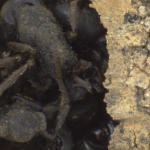carcass
Bone-house wasps protect their young by building walls made of ant carcasses. Image from: Merten Ehmig
A new species of spider wasp that protect their young with walls made of ant carcasses has been discovered in the forests of China. Dr. Michael Staab from the University of Freiburg discovered the new species which he named Deuteragenia ossarium meaning "bone-house wasp" since the wasps reminded him of the ossuaries in Europe with structures decorated from human bones.
Sedlec Ossuary in the Czech Republic. Image from Wikipedia.
Similar to the ossuaries, the bone-house wasps use alive…
The fail whale comes to rest; the decomposing body of a gray whale is host to a diverse array of scavengers and other deep sea organisms. From Goffredi et al., 2004.
In the deep sea, no carcass goes to waste. Platoons of crabs, fish, and other scavengers make short work of most of the bodies which come to rest on the sea bottom, but every now and then the carrion-eaters are presented with a rotting bonanza; a whale fall. Muscle, viscera, blubber, and bone; it all gets broken down, but it takes so long that the whale carcass actually provides a temporary home for a variety of organisms…
I was planning on putting up one of my patented mega-posts this evening, but unfortunately I just don't have it in me at the moment. It's based on a presentation I made today involving scavenging and early hominids, and while I'm sure some of you will be able to make the right connections (especially if you're familiar with the work of a certain Rutgers alum) here's a video of a certain behavior exhibited by one of my most favorite big cats, the Leopard (Panthera pardus), that'll prominently figure in tomorrow's discussion;
